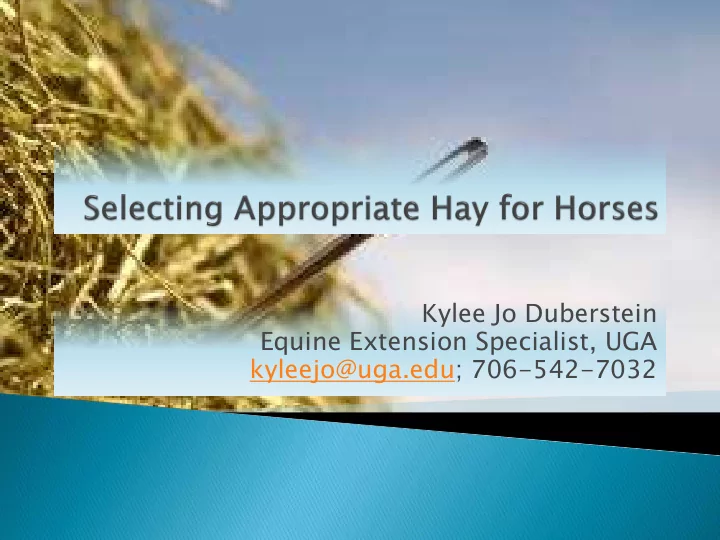

Kylee Jo Duberstein Equine Extension Specialist, UGA kyleejo@uga.edu; 706-542-7032
What types of hay do they feed? Square vs. Round bales Forage test Sensory properties Delivery and storage Cost
Digestibility ◦ Maturity—stage when harvested ◦ Moisture content ◦ Stem to leaf ratio (more leaves=better quality) Free of dust, weeds, mold Storage for horses
Colic Ulcers
Grass hay ◦ Bermudagrass Coastal vs. other hybrids The colic dilema ◦ Timothy, Orchardgrass ◦ Tall fescue—endophyte contamination ◦ Ryegrass—problematic for sugar sensitive horses Legumes ◦ Alfalfa ◦ Perennial peanut ◦ Red clover—slobbers ◦ Lespedeza
Selecting a forage bermudagrass variety. UGA Cooperative Extension. Dennis W. Hancock, Norman R. Edwards, T. Wade Green, Deron M. Rehberg.
Horses can be very sensitive to molds ◦ Storage is very important Tall fescue ◦ Endophyte produces ergovaline—reproductive problems Sweet clover ◦ Moldy plants produce dicumerol Red clover ◦ Rhizoctonia leguminicola ◦ Slaframine
Comparison of the effects of E+ and E- tall fescues on gestation length, foal mortality, agalactia, incidence of placental retention, and rebreeding response in mares (adapted from Monroe et al., 1988). Stars indicate significant difference between treatments ( P < 0.05). Fribourg, H. A., D. B. Hannaway, and C. P. West (ed.) 2009. Tall Fescue for the Twenty-first Century. Agron. Monog. 53. ASA, CSSA, SSSA. Madison, WI. 540 pp. Also (http://forages.oregonstate.edu/tallfescuemonograph).
Blister beetles ◦ Cantharidin ◦ Alfalfa ◦ ¼”X 3/4” ◦ Cutting of hay
Urea ◦ NPN ◦ Digestion in rumen vs. stomach/small intestine Conversion to CO 2 and ammonia ◦ Toxicity: 0.3-0.5 g/ lethal 1-1.5 g/kg; horses 4 g/kg Forage nitrate accumulation ◦ Sudan grasses, Johnsongrass, Bermudagrass, Tall Fescue, Ryegrass, Pearl Millet, Crabgrass ◦ Higher concentration following heavy fertilization ◦ <4500 ppm dry forage safe Horses may tolerate closer to 10,000 ppm
DE most important; ADF, NDF Protein ◦ Good quality grasses: 10-16% CP on DM basis ◦ Good quality legumes: 18-22% CP on DM basis Also should include % moisture ◦ No less than 10% (leaf shattering) ◦ No more than 15-18% (mold, combustion) Minerals, esp. Ca, P
http://animal.ifas.ufl.edu/extension/equine/documents/2006EquineInstit/SelectingHay.pdf
Addit dditio ional c l consid idera ratio ions: DE less than 0.75 Mcal/lb are not suitable for horses ADF greater than 45% are not very digestible to horses NDF greater than 65% are not readily eaten by horses ADF less than 31% considered excellent NDF less than 40% considered excellent
http://animal.ifas.ufl.edu/extension/equine/documents/2006EquineInstit/SelectingHay.pdf
DE (kcal/kg DM) = 2,118 + 12.18 (CP%) - 9.37 (ADF %) -3.83 (hemicellulose %) + 47.18 (fat %) + 20.35 (NSC) - 26.3 (ash %) DE(kcal/kg) = 255 + 3660 x TDN
Need to determine: ◦ Cost of hay/pound ◦ Mcal of DE/$ Example le 1 1 ◦ 50 lb bale of bermudagrass that costs $5.00 ◦ $5.00/50 lbs = $0.10/lb If that bale of hay had 0.80 Mcal DE/lb ◦ .80 Mcal DE/lb X 1 lb/$0.10 = 8 Mcal DE/$1.00 Example le 2 2 ◦ What about a bale of alfalfa that costs $10.00/bale and has 1.00 Mcal DE? ◦ $10.00/50 lbs = $0.20/lb ◦ 1 Mcal DE/lb X 1 lb/$0.20 = 5 Mcal DE/ $1.00
NSC vs ESC vs WSC WSC ◦ Simple sugars, disaccharides, oligosaccharides, and some polysaccharides ◦ Includes fructans ◦ Glycemic response depends on % of fructans ESC ◦ Subset of WSC ◦ Includes sugars, disacharides, oligosaccharides and some fructans ◦ Typically induces high glycemic response NSC ◦ WSC+starch
Average sugar, starch, and non- structural CHOs FEED EEDSTU TUFF SUGA SUGAR STA TARCH RCH NSC SC Oat hay 16.0% 6.3% 22.3% Alfalfa hay 8.9% 2.5% 11.4% Bermudagrass hay 7.5% 6.1% 13.6% Grass hay 11.1% 2.9% 13.8% Beet pulp 10.7% 1.4% 12.1% Oats 6.3% 44.4% 50.7% Corn 3.7% 70.3% 74.0% Wheat middlings 10.1% 26.2% 36.3% Soybean meal 14.3% 2.1% 16.4%
http://www.caes.uga.edu/applications/publications/files/ pdf/B%201224_2.PDF http://www.ker.com/library/equinews/v9n2/v9n210.pdf http://www.agry.purdue.edu/ext/forages/publications/ID -190.htm http://animal.ifas.ufl.edu/extension/equine/documents/2 006EquineInstit/SelectingHay.pdf http://www2.ca.uky.edu/agc/pubs/id/id146/id146.htm http://animalscience.tamu.edu/files/2012/04/equine- selection-usage-hay-processed-roughage11.pdf
kyleejo@uga.edu 706-542-7032
Recommend
More recommend